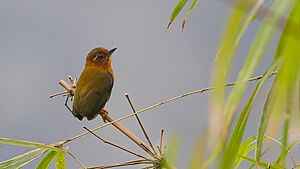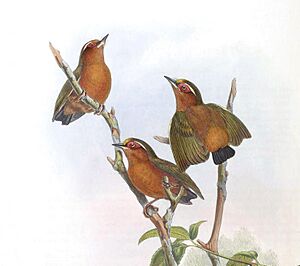White-browed piculet facts for kids
Quick facts for kids White-browed piculet |
|
|---|---|
 |
|
| From Khangchendzonga National Park, West Sikkim, India. | |
| Conservation status | |
| Scientific classification | |
| Genus: |
Sasia
|
| Species: |
ochracea
|
The white-browed piculet (scientific name: Sasia ochracea) is a tiny bird. It belongs to the Picidae family, which includes woodpeckers. You can find this bird in many countries across Asia. These include Bangladesh, Bhutan, Cambodia, India, Laos, Myanmar, Nepal, Thailand, and Vietnam. It likes to live in forests, especially cool forests or warm, wet mountain forests.
Contents
What Does the White-browed Piculet Look Like?

This small bird is about 10 cm (4 in) long. Its back and wings are olive-green. They might have a hint of reddish-brown. Its belly and chest are a warm cinnamon or reddish-brown color. Sometimes, its sides are yellowish.
The piculet has a short, blackish tail. The top of its head is green. You can spot a white stripe just above and behind its eye. Around its eye, there's a ring of bare skin that looks pink or reddish.
Male piculets have a small, golden-yellow patch on their forehead. Females do not have this patch. Young piculets are not as brightly colored as adults. They are greener on top and grayer underneath.
Its beak is gray, and its eyes are red. Its legs are yellow or orange. Unlike most woodpeckers, which have four toes, the white-browed piculet has only three toes on each foot.
You might confuse this bird with the rufous piculet in some areas. However, the white-browed piculet has that clear white stripe above its eye. It also has a darker beak.
Where Do White-browed Piculets Live?
The white-browed piculet lives in tropical parts of Southeast Asia. Its home stretches from northern India, Nepal, Bhutan, and Bangladesh. It also lives through southern China to Myanmar, Laos, Vietnam, and Thailand.
This bird prefers dense forests. These can be wet or dry forests. It especially likes places with lots of vines and bamboo. You can also find it in scrublands and swampy woodlands. It lives in areas up to 2,600 m (8,500 ft) high in the mountains.
How White-browed Piculets Live and What They Eat
The white-browed piculet looks for food close to the ground. It pecks and probes with its sharp beak. Its diet includes small insects like bark beetles, ants, and termites. It also eats spiders and other tiny creatures without backbones.
These birds often search for food in pairs. They might also join small groups of different bird species. Sometimes, they even hop on the ground for short distances to find food.
When it's time to build a nest, this bird uses pieces of bamboo. It picks up broken bamboo bits with its feet. Then, it uses its beak to pull away any partly broken pieces to make a cozy home. White-browed piculets usually breed between March and July.
How is the White-browed Piculet Doing?
The white-browed piculet is quite a common bird. It lives across a very large area. We don't know of any major threats to this bird. Because of this, its population is thought to be stable.
The International Union for Conservation of Nature (IUCN) has looked at this bird's situation. They have decided its conservation status is "least concern". This means it's not currently in danger of disappearing.


